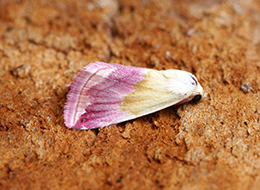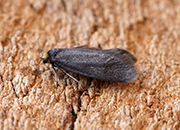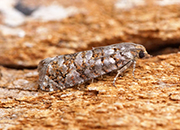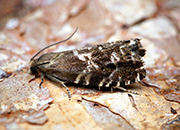Canvey Wick - Field Trip 08/07/10
Canvey Island is situated right at the mouth of the Thames and because of its close proximity to the coast and the County of Kent it has over the years been a hotspot for Essex and the migrant moths that we get from Europe. A former Occidental site where an oil refinery was set-up in the 1970s which subsequently became disused and as a result the surrounding wildlife quickly took over the huge expanse of set aside land.
On the evening of the 8th July 2010 it was agreed that Graham Bailey, Don Down and myself would venture down to the Canvey Wick area of Canvey Island. The evening was extremely mild with a warm breeze coming across from the south and on arrival many moths were seen in the car headlights. As we strolled along the undergrowth towards the concrete circles left after the oil drums were removed I noticed how messy and dangerous this place was with pieces of glass, wood and barbed wire littered everywhere, no doubt protecting the wildlife from any human being daring enough to enter!
After a painful walk we decided to set up 3 lights spread out in a small triangle, Don suggested that the best places to position the lights would be on the flat tarmac surfaces, as these were still almost warm to the touch from the sun’s rays during the day. It would also be easy to spot any unsuspecting moth that had landed a good distance away from the lights.
First light on was Don’s 125w MV tripod arrangement which was ideal as it is extremely light and portable. Egg trays were positioned around the light’s base and it didn’t take long for the moths to notice it! Within minutes we were overwhelmed by micro moths.
Over the course of several hours literally hundreds and hundreds of moths were observed at Don’s and Graham’s light, my light did not fare as well, probably due to its lower UV emission.
We were all surprised at how far away the moths were settling away from the lights themselves, some a good 20 metres away, Swallow-tailed Moths and Lappet Moths in particular.
An estimate of 1500 moths at one time wouldn’t have been far from reality and the species count kept rising every time we looked somewhere different.
Graham Bailey & Don Down checking the egg trays around Don’s 125w MV tripod.
In total we recorded 150 species of moth. Of the 150 moths 21 were micro-moths the remaining 129 species were all macro-moths and included 10 totally new for me, Graham’s first ever Crescent Striped and Don’s first ever Essex Beautiful Snout, which was a County 2nd record.
2x Leopard Moth10x Crambus perlella
6x Catoptria pinella
20x Platytes alpinella
1x Schoenobius gigantella
5x Donacaula forficella
30x Acentria ephemerella
1x Cataclysta lemnata
4x Pyrausta despicata
2x Ostrinia nubilalis
2x Eurrhypara hortulata
1x Phlyctaenia coronata
3x Phlyctaenia perlucidalis
2x Ebulea crocealis
2x Udea prunalis
1x Udea olivalis
1x Pleuroptya ruralis
1x Pleuroptya ruralis
100x Synaphe punctalis
5x Endotricha flammealis
20x Melissoblaptes zelleri
30x Oncocera semirubella
35x Lackey
5x Drinker
7x Lappet
1x Oak Hook-tip
3x Pebble Hook-tip
1x Chinese Character
5x Buff Arches
3x Figure of Eighty
4x Large Emerald
5x Common Emerald
1x Small Emerald
1x Small Blood-vein
2x Rosy Wave
3x Lesser Cream Wave
3x Least Carpet
6x Dwarf Cream Wave
1x Small Dusty Wave
1x Single-dotted Wave
1x Satin Wave
1x Treble Brown Spot
4x Small Scallop
25x Riband Wave
1x Shaded Broad-bar
2x Barred Straw
3x Common Marbled Carpet
10x Barred Yellow
3x July Highflyer
3x Brown Scallop
20x Slender Pug
1x Lime-speck Pug
1x Wormwood Pug
4x Bordered Pug
3x Shaded Pug
1x Plain Pug
2x V-Pug
5x Green Pug
2x Double-striped Pug
2x Small Yellow Wave
1x Magpie Moth
15x Clouded Border
8x Sharp-angled Peacock
2x Latticed Heath
3x Brimstone Moth
2x Early Thorn
10x Scalloped Oak
10x Swallow-tailed Moth
7x Peppered Moth
5x Willow Beauty
4x Engrailed
8x Common White Wave
2x Common Wave
15x Clouded Silver
3x Light Emerald
1x Privet Hawk-moth
2x Eyed Hawk-moth
5x Poplar Hawk-moth
6x Elephant Hawk-moth
7x Buff-tip
1x Iron Prominent
3x Pebble Prominent
1x Swallow Prominent
4x Coxcomb Prominent
2x Maple Prominent
6x Pale Prominent
20x Brown-tail
2x Yellow-tail
1x Round-winged Muslin
1x Rosy Footman
1x Dingy Footman
15x Scarce Footman
10x Common Footman
1x Buff Ermine
10x Kent Black Arches
4x Short-cloaked Moth
10x White-line Dart
20x Heart and Dart
10x Flame
2x Flame Shoulder
5x Large Yellow Underwing
3x Lesser Yellow Underwing
6x Broad-bordered Yellow Underwing
2x Setaceous Hebrew Character
2x Double Square-spot
4x Bright-line Brown-eye
5x Brown-line Bright Eye
25x Clay
2x White-point
10x Southern Wainscot
30x Smoky Wainscot
2x Common Wainscot
5x Obscure Wainscot
7x Shark
3x Star-wort
4x Poplar Grey
1x Sycamore
3x Grey Dagger
2x Marbled Beauty
4x Angle Shades
2x Olive
1x Dingy Shears
30x Dun-bar
5x Lunar-spotted Pinion
30x Dark Arches
30x Light Arches
1x Crescent Striped
1x Clouded Brindle
4x Dusky Brocade
20x Marbled Minor
10x Cloaked Minor
5x Common Rustic
25x Fen Wainscot
10x Uncertain
15x Rustic
1x Vine's Rustic
10x Mottled Rustic
1x Silky Wainscot
2x Bordered Sallow
7x Marbled White Spot
7x Cream-bordered Green Pea
4x Nut-tree Tussock
1x Burnished Brass
1x Silver Y
1x Herald
1x Beautiful Snout
2x Snout
1x Pinion-streaked Snout
3x Small Fan-foot
10x Dotted Fan-foot

 Musotima nitidalis
Musotima nitidalis L-album Wainscot
L-album Wainscot Feathered Ranunculus
Feathered Ranunculus Agonopterix nervosa
Agonopterix nervosa Blossom Underwing
Blossom Underwing Beautiful Marbled
Beautiful Marbled Lampronia fuscatella
Lampronia fuscatella Gravitarmata margarotana
Gravitarmata margarotana Perittia obscurepunctella
Perittia obscurepunctella Black-spotted Chestnut
Black-spotted Chestnut Cydia pactolana
Cydia pactolana
















































Good grief Ben, what a haul! Theres 50 new species for me in there!!
ReplyDeleteYep very memorable and doubt I will ever come close again to those perfect conditions!
ReplyDelete